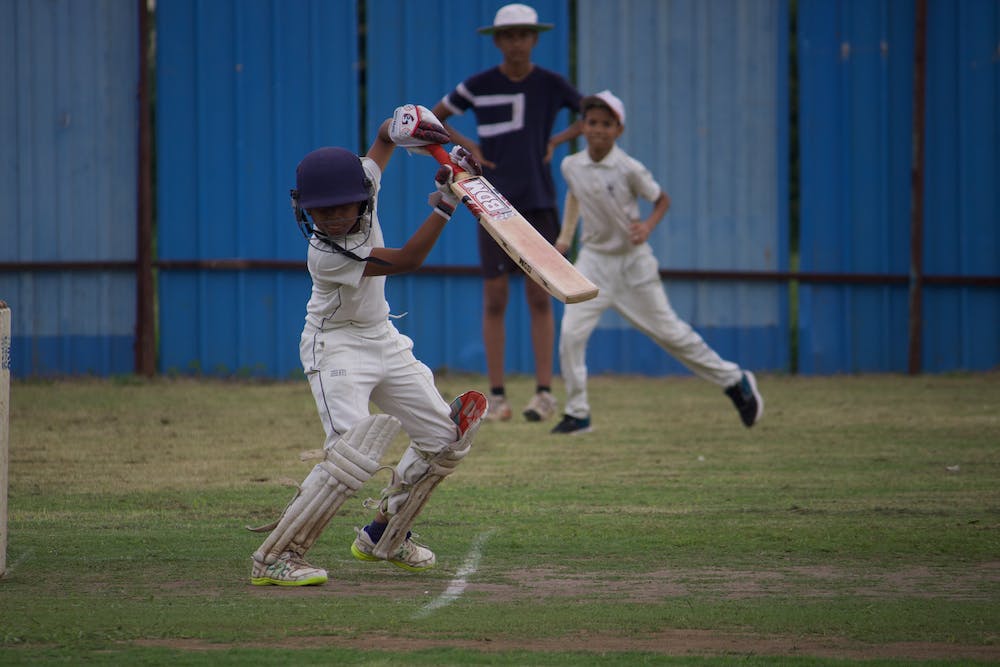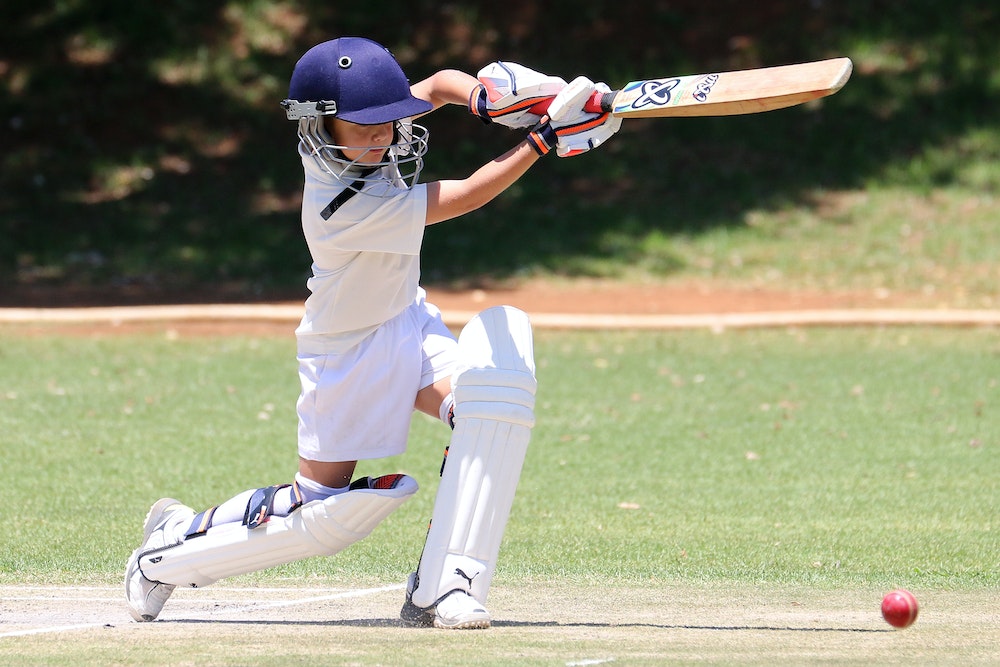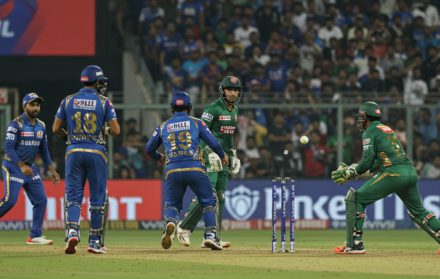
Introduction to Cricket for Kids
Cricket, a popular sport in many Commonwealth countries, holds significant cultural and historical importance. Introduction to cricket for kids not only exposes them to a fun and engaging game but also instills teamwork, discipline, and sportsmanship values. This comprehensive guide will acquaint children with the basics of cricket and lay the foundation for their cricketing journey.
Cricket is a bat-and-ball game played between two teams, each consisting of eleven players. With roots dating back to the 16th century, it has evolved into an organized sport played at various levels, from casual backyard matches to international competitions.
To play cricket, teams take turns batting and fielding. The batting team aims to score runs by hitting the ball and running between wickets, while the fielding team strives to dismiss the opposition’s batsmen and restrict their scoring.
Understanding the equipment is vital in cricket. Players use a bat to hit the ball, a ball made of cork and covered in leather, and wear protective gear including helmets, pads, and gloves.
Knowing the basic rules of cricket is essential. Players score runs by running between wickets or hitting boundaries, while the fielding team seeks to take wickets and prevent runs. The game is played in innings, with each team having a turn to bat and field.
Scoring and rules in cricket involves various methods, including runs scored by running, boundaries, and extras awarded for the opposing team’s mistakes. The team that scores the most runs wins the game.
Cricket offers different formats, including Test matches, One-Day Internationals (ODIs), and Twenty20 (T20) matches, each varying in duration and gameplay.
Familiarizing children with famous cricket players not only provides inspiration but also allows them to learn from accomplished athletes’ skills and techniques.
Playing cricket offers numerous benefits, including physical fitness, hand-eye coordination, teamwork, discipline, and strategic thinking.
Understanding cricket terminology is essential to comprehend the game better, including terms like wicket, innings, bowler, batsman, and umpire.
Encouraging children to play cricket can enhance their physical well-being, develop their skills and abilities, and foster a love for the sport.
To improve cricket skills, kids can practice batting, bowling, and fielding techniques, seek guidance from coaches, and participate in organized training sessions.
Cricket has gained popularity globally, especially in Commonwealth countries such as India, England, Australia, and South Africa, where it is considered a major sport.
By introducing children to the exciting world of cricket, they can develop a passion for the sport, learn valuable life lessons, and potentially pursue a rewarding cricketing journey.
Cultivating a Love for Cricket: A Kid-Friendly Guide to Sixes Social Cricket
Introducing cricket to kids can be an exciting adventure, and what better way to ignite their passion for the sport than with the dynamic and engaging experience of Sixes Social Cricket? Here’s a step-by-step guide to creating a memorable and enjoyable introduction to cricket for the young enthusiasts:
1. Set the Stage for Excitement: Begin by building anticipation. Share fascinating facts about cricket, its history, and the thrill of the game. Emphasize the camaraderie, sportsmanship, and the joy of playing cricket with friends. Sparking curiosity is the first step to capturing their interest.
2. Craft a Cricket-Themed Invitation: Kick off the excitement by sending out cricket-themed invitations. Whether it’s a playful cricket ball design or a creative play on cricket terms, the invitation sets the tone for a fun and unique experience at Sixes Social Cricket.
3. Choose an Appropriate Time: Select a time that aligns with the kids’ energy levels and schedules. After-school sessions or weekend gatherings often work well. Ensure that the chosen time allows for a relaxed and enjoyable experience at Sixes Social Cricket.
4. Familiarize Kids with Cricket Basics: Before the event, offer a basic overview of cricket rules and terminology. Explain the concepts of batting, bowling, and fielding in a simple and engaging manner. Utilize visuals or short videos to make the learning process interactive and fun.
5. Arrange a Kids’ Cricket Session at Sixes: Book a session at Sixes Social Cricket, ensuring that it’s tailored to the age and skill level of the kids. The multiplayer batting challenge, with virtual representations of renowned bowlers, provides an exciting and age-appropriate introduction to the game.
6. Emphasize Fun Over Competition: Create an environment where fun is the priority. Emphasize the joy of playing rather than focusing solely on competition. The numbered targets in the nets at Sixes add an element of playfulness, allowing kids to focus on hitting targets and accumulating points in a lighthearted manner.
7. Incorporate Cricket-Themed Games: Enhance the cricketing experience with additional games and challenges. Consider cricket-themed relay races, simple batting and bowling drills, or friendly competitions. These activities keep the kids engaged while reinforcing fundamental cricket skills.
8. Provide Basic Equipment: Ensure that the kids have access to appropriate cricket equipment. While Sixes Social Cricket provides a virtual experience, having soft cricket balls, lightweight bats, and cones for markers can add a tactile dimension to the introduction.
9. Celebrate Achievements: Recognize and celebrate the kids’ achievements during the session. Whether it’s hitting a target, making a successful catch, or bowling accurately, acknowledge their efforts with positive reinforcement. This fosters a sense of accomplishment and boosts their confidence.
10. Conclude with Refreshments and Fun: Wrap up the cricket session with a spread of kid-friendly refreshments. Sixes Social Cricket’s culinary offerings, including burgers, wood-fired pizzas, and more, make for a delightful post-game feast. Create a festive atmosphere with celebratory treats and perhaps a small cricket-themed goody bag for each child.
By introducing cricket to kids through the engaging and innovative experience of Sixes Social Cricket, you’re not just teaching them a sport—you’re instilling a love for camaraderie, teamwork, and the joy of play. Cheers to cultivating the next generation of cricket enthusiasts in a way that’s as fun as it is educational!
What is Cricket?

Cricket is a popular sport played in many countries. It involves two teams of eleven players. The objective of the game is for one team to score more runs than the other.
Here are some key aspects:
- Pitch: Cricket is played on a grassy field called a pitch. It is a rectangular area with a flat surface.
- Wickets: Each team has two wickets, consisting of three vertical stumps and two bails. The batsman protects the wickets while the bowler tries to hit them.
- Innings: A cricket match has two innings. Each team takes turns to bat and field. They aim to score runs within a specific time limit while the opposing team tries to take wickets and limit the scoring.
- Runs: The batting team scores runs by running between the wickets after hitting the ball. They can also score runs by hitting the ball to the boundary, resulting in four runs, or over the boundary without bouncing, resulting in six runs.
- Bowling: The bowling team delivers the ball to the batsman, aiming to hit the wickets or force the batsman into making a mistake and getting out.
- Batting and Fielding: The batting team aims to score runs while the fielding team tries to stop them and take wickets by catching the ball or hitting the wickets.
Suggestions for beginners in cricket:
- Understand the basic rules and terminology of cricket.
- Regularly practice batting and bowling skills to improve technique.
- Observe and learn from experienced players by watching professional cricket matches.
- Join a local cricket club or enroll in coaching sessions to receive proper guidance.
- Be patient and persistent, as cricket requires practice and dedication to master.
By following these suggestions, you can develop your skills and enjoy playing the exciting game of cricket.
How is Cricket Played?
Cricket is played by two teams, each with eleven players. The objective is to score more runs than the opposing team. Here is a step-by-step guide on how cricket is played:
1. Toss: Before the game begins, the team captains meet with the match referee for a coin toss. The winning captain decides whether to bat or field.
2. Innings: One team bats while the other fields. The batting team aims to score runs by hitting the ball and running between two sets of wickets at each end of the pitch. The fielding team tries to dismiss the batsmen and limit runs.
3. Batsmen: The two batsmen take turns facing the bowler. They try to score runs by hitting the ball with their bats while protecting their wickets.
4. Bowling: The fielding team’s bowler delivers the ball to the batsman, who tries to hit it. The bowler aims to dismiss the batsman by hitting the wickets or catching the ball.
5. Scoring runs: Batsmen score runs by running between the wickets. Each completed run adds one to the team’s score. Runs can also be scored by hitting boundaries, such as fours or sixes.
6. Dismissals: The fielding team attempts to dismiss the batsmen by catching the ball in the air, hitting the wickets, or trapping the batsman in front of the wicket. Once a batsman is dismissed, a new batsman takes their place.
7. Overs: The game is divided into overs, each consisting of six deliveries. After every over, the batting and fielding positions are swapped.
8. Second Innings: Once the first innings is completed, the teams switch roles. The team that fielded now gets a chance to bat, and the team that batted tries to defend the runs they scored.
9. Result: The team with the higher score at the end of both innings wins. In the event of a tie, additional rules like a Super Over or Duckworth-Lewis method may be used to determine the winner.
Remember, cricket is a complex game. Learn and understand the rules fully before playing or watching a match.
Cricket Equipment
Cricket Equipment has played a significant role in the evolution of the sport that originated in England in the 16th century. From the first recorded cricket match in the 17th century to the establishment of the first international cricket board, the Imperial Cricket Conference, in 1909, equipment advancements have enhanced player safety and performance.
The formation of England’s national cricket team in 1844 further led to the organization and popularity of cricket, with different formats like Test cricket, One Day Internationals (ODIs), and Twenty20 cricket captivating a wider audience. In this rich history and heritage, cricket equipment has remained fundamental to the success of the game, attracting millions of fans worldwide who tune in to watch matches.
Basic Cricket Rules
Understanding the basic cricket rules is essential for anyone interested in the sport. Here are the fundamental rules that every cricket player should know:
1. Teams: Cricket is played between two teams of eleven players each.
2. Toss: Before a match starts, a coin is tossed to determine which team will bat first.
3. Wickets: The batting team has two wickets, or sets of three stumps, at each end of the pitch.
4. Bowling: The bowler delivers the ball to the batsman from one end of the pitch.
5. Batting: The batsman tries to hit the ball and score runs by running between the wickets.
6. Runs: The batsman scores runs by hitting the ball and running between the wickets. They can also score runs by hitting the ball to the boundary, earning four runs, or hitting it over the boundary without bouncing, earning six runs.
7. Dismissals: The batsman can be dismissed in several ways, including being bowled, caught, run out, stumped, or leg before wicket (LBW).
8. Overs: The game is divided into overs, with each over consisting of six deliveries from the bowler.
By understanding and following these basic cricket rules, players can fully participate in the game and enjoy the excitement and challenges it offers.
Scoring in CricketScoring in cricket is crucial in determining the performance of both teams and individuals. To truly enjoy and appreciate the sport, young cricket enthusiasts must have a clear understanding of how scoring works.
Understanding these scoring methods helps children keep track of the game and appreciate the skills of the players. The total number of runs scored by a team or individual reflects their overall performance in a match. Encourage young players to practice their batting and running between the wickets to improve their scoring abilities.
It is important for them to remain focused, observe the ball carefully, make confident shots, and communicate effectively with their teammates to avoid unnecessary run-outs. Regular practice and dedication will enhance their scoring proficiency and contribute to their overall performance in the game.
By understanding the various ways to score and consistently honing their skills, children can enjoy playing cricket while positively impacting their team’s success.
Types of Matches
Cricket also offers additional match types. For instance, domestic leagues like the Indian Premier League (IPL) and the Big Bash League (BBL) feature city-based teams competing in the T20 format.
During the 2019 Cricket World Cup, the group stage match between England and New Zealand ended in a tie. A Super Over was conducted to determine the winner. Both teams scored the same number of runs in the Super Over, resulting in another tie.
Eventually, England won based on the boundary count rule, which awards the victory to the team with the most boundaries throughout the match. This thrilling encounter showcased the excitement and unpredictability of cricket matches.
Whether it’s a five-day Test match or a fast-paced T20 game, each type of cricket match offers a unique experience, catering to different preferences and skill sets. Dive into the world of cricket and explore the various matches that this sport has to offer.
Famous Cricket Players
Many famous cricket players have had a long-lasting impact on the sport. They showcased their abilities and talents, becoming celebrated figures. Here is a compilation of some of the most distinguished cricket players:
1. Sachin Tendulkar: Known as the “Master Blaster,” Tendulkar is considered one of the finest batsmen in cricket history. He holds numerous records, including the highest number of runs scored in international cricket.
2. Don Bradman: Bradman is often referred to as the greatest batsman of all time. His extraordinary batting average of 99.94 remains unmatched.
3. Virat Kohli: Kohli is the current captain of the Indian cricket team. He is recognized for his aggressive and consistent batting and has broken several records.
4. Shane Warne: Warne is one of the greatest spin bowlers in cricket. His ability to spin the ball and deceive batsmen made him a formidable force.
5. Wasim Akram: Akram was a fast bowler who could swing the ball in both directions. He is widely regarded as one of the finest left-arm pacers in the game’s history.
These famous cricket players have not only entertained fans with their skills but also inspired a new generation of cricketers. Their contributions have left a lasting legacy, and their names will forever be engraved in cricket’s history.
Benefits of Playing Cricket
Playing cricket brings about a multitude of benefits. Here are some of the key advantages that come with being involved in this sport.
1. Physical fitness: Cricket involves a combination of running, throwing, and batting, which effectively enhances cardiovascular health, endurance, and overall fitness levels.
2. Teamwork and cooperation: Being a team sport, cricket promotes the values of teamwork, cooperation, and camaraderie among players. It helps them foster social skills and develop strong bonds with their teammates.
3. Mental agility: Cricket demands strategic thinking and quick decision-making, ultimately improving mental agility, concentration, and problem-solving abilities.
4. Hand-eye coordination: Batting in cricket necessitates exceptional hand-eye coordination, resulting in the enhancement of reflexes and motor skills.
5. Discipline and perseverance: Cricket instills crucial life skills such as discipline, dedication, and hard work. It teaches individuals virtues like patience and the ability to bounce back from setbacks.
6. Character development: Engaging in cricket encourages good sportsmanship, fair play, and respect for both opponents and teammates. It cultivates values like integrity, discipline, and humility.
7. Stress relief: Partaking in cricket provides a therapeutic outlet to unwind, have fun, and alleviate stress and anxiety.
Cricket originated in England during the 16th century and gained significant popularity within the British Empire. Its widespread appeal led to the establishment of the International Cricket Council (ICC) to oversee the sport globally. Today, cricket is played at various levels, including prestigious international tournaments like the Cricket World Cup and the Ashes series contested between England and Australia.
By embracing the game of cricket, individuals not only improve their physical fitness and mental prowess but also develop essential life skills. They become part of a vibrant global sporting community.
Introduction to Cricket for Kids: Cricket Terminology
Stump: The wooden structure that the batsman defends and the bowler aims to hit.
Runs: The unit of scoring in cricket. Batsmen accumulate runs by hitting the ball and running between the stumps.
Boundary: The edge of the field. If the batsman hits the ball and it reaches the boundary without bouncing, they are awarded four runs. If the ball is hit over the boundary without bouncing, it is a six.
Innings: Each team has one or two innings in a cricket match. An inning is completed when all players in the batting team are dismissed or the captain declares.
Bowling: Delivering the ball towards the batsman. Bowlers aim to get the batsman out by hitting the stumps or causing them to hit the ball into the fielder’s hands.
Fielding: Stopping the ball, retrieving it, and preventing the batsmen from scoring runs. Fielders can catch the ball in the air or stop it with their bodies.
LBW (Leg Before Wicket): A dismissal where the ball hits the batsman’s leg in front of the wicket and the umpire deems it would have hit the wicket if the leg wasn’t there.
Bouncer: A fast and high-pitched delivery aimed at intimidating the batsman.
Yorker: A delivery aimed at the batsman’s feet, making it difficult for them to hit the ball.
Duck: When a batsman gets out without scoring any runs in their innings.
Pro Tip: Familiarise yourself with common cricket terminology to better understand the game and enjoy the conversations surrounding it. Watch matches and read cricket articles to enhance your knowledge and appreciation for the sport.
How to Improve Cricket Skills?
To improve your cricket skills, here are the essential steps you need to follow:
1. Develop the habit of regular practice: Allocate dedicated time each week to practice batting, bowling, and fielding. Consistency is key when it comes to enhancing your performance.
2. Concentrate on technique: Pay close attention to your grip, stance, and body position while batting. Refine your bowling action and accuracy. Practice catching and throwing techniques for fielding.
3. Engage in net sessions: Join net sessions or practice matches with fellow players to simulate real-game scenarios. This will help you develop your skills under pressure and improve your decision-making abilities.
4. Prioritize fitness: Cricket requires good stamina and agility. Incorporate regular fitness training into your routine, including cardiovascular exercises, strength training, and flexibility exercises.
5. Observe and learn: Analyze professional cricket matches and carefully observe the techniques, strategies, and decision-making skills of experts. Watching and understanding the game can teach you a lot.
6. Seek feedback: Request feedback from experienced coaches, teammates, or professional players. They can provide valuable insights and suggestions to enhance specific aspects of your game.
7. Participate in competitive matches: Take part in local cricket leagues or tournaments to gain experience in match situations. Competitive matches will allow you to apply your skills and build confidence under pressure.
8. Be mentally prepared: Cricket requires decision-making abilities, concentration, and resilience. Improve your mental strength through visualization techniques, meditation, and mental preparation drills.
Remember, improving cricket skills takes time, effort, and dedication. By practicing consistently, focusing on technique, and seeking feedback, you can enhance your performance and become a better cricket player. Enjoy the process and always have a passion for the game.
Is Cricket a Popular Sport?
Cricket is a popular sport that is highly regarded and enjoyed by millions of individuals across the globe. It possesses a deep-rooted history and tradition that can be traced back to the 16th century in England. The sport has expanded to multiple countries and has become an integral component of the culture and identity of nations belonging to the British Commonwealth.
Cricket’s appeal stems from its unique combination of skill, strategy, and athleticism, which attracts both players and spectators alike. The game encompasses batting, bowling, and fielding, making it a challenging and exhilarating sport.
One of the reasons behind cricket’s popularity is its global presence. It can be played in various formats, including Test matches, One-Day Internationals (ODIs), and Twenty20 (T20) matches, providing different avenues for fans to relish the game. Prominent tournaments such as the ICC Cricket World Cup and the Indian Premier League boast a massive fan base and generate substantial revenue.





